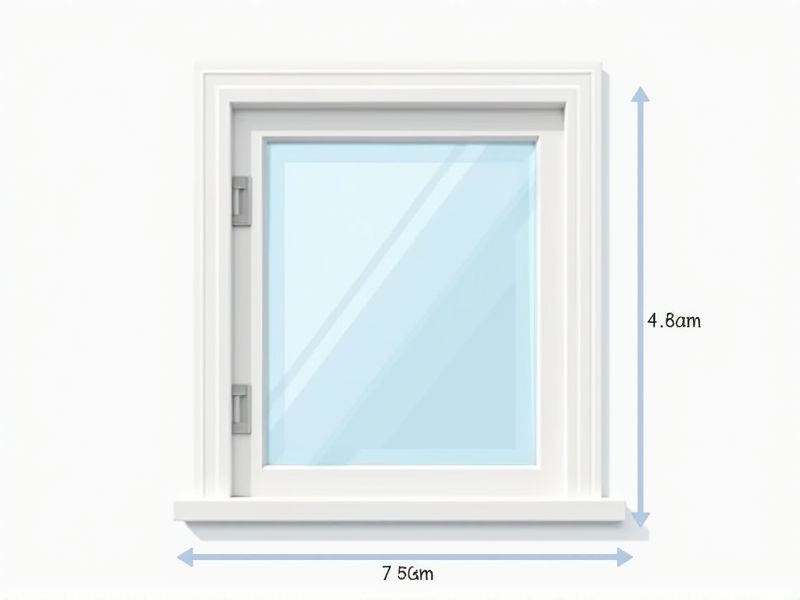
Standard window dimensions can vary based on the style and region, but most residential windows fall within a typical size range to fit common construction frames. For example, single- or double-hung windows often come in widths of 24 to 48 inches and heights of 36 to 72 inches. Larger windows like picture or casement types can range from 24 to 96 inches wide and 12 to 96 inches high. Understanding these standard dimensions can help you plan renovations or replacements efficiently, ensuring easier installation and better compatibility with prefabricated options.
Energy Efficiency
The standard for energy-efficient windows emphasizes a low U-factor, ideally below 0.30, which measures the rate of heat transfer; this indicates the window's insulating effectiveness. Solar Heat Gain Coefficient (SHGC) ratings are also crucial, with an optimal value below 0.25 for climates with high cooling demands. Double or triple glazing, along with low-emissivity (Low-E) coatings, significantly enhances thermal performance, reducing energy costs by 15-20% compared to single-pane windows. Selecting windows that meet these standards not only improves your home's comfort but also contributes to lower greenhouse gas emissions.
Natural Lighting
Natural lighting in windows significantly impacts energy efficiency and indoor comfort, with studies revealing that well-placed windows can reduce reliance on artificial lighting by up to 40%. Ideally, window orientation should maximize exposure to daylight, with south-facing windows receiving the most sunlight throughout the day. The use of high-performance glazing can enhance thermal insulation, keeping indoor temperatures stable and further improving energy savings. Incorporating skylights can also increase daylight penetration, potentially increasing productivity and well-being in residential and commercial spaces.
Ventilation
The standard window size for effective ventilation typically ranges from 10% to 15% of the floor area of the room. Properly designed windows facilitate air exchange, improving indoor air quality by allowing up to 125 cubic feet of fresh air per minute. Energy-efficient windows with double-glazing and low-emissivity coatings can significantly reduce heating and cooling costs, resulting in potential savings of 20% to 30% on energy bills. A well-placed operable window can provide optimal cross-ventilation, enhancing comfort and reducing reliance on mechanical cooling systems.
Aesthetic Appeal
Aesthetic appeal in window design incorporates elements such as shape, color, and material to enhance the overall look of a building. High-quality windows can significantly influence a property's market value, with aesthetically pleasing designs potentially increasing value by up to 10%. Modern trends showcase larger panes and minimalist frames, allowing for maximum natural light and unobstructed views. Selecting energy-efficient windows that complement your home's architectural style can lead to both visual satisfaction and practical benefits.
Building Codes
Building codes often specify standards for window design, which include minimum sizes and energy efficiency ratings. For instance, the International Building Code (IBC) mandates that all bedrooms have windows with at least 5.7 square feet for emergency egress. Furthermore, energy performance is usually evaluated via U-factor and Solar Heat Gain Coefficient (SHGC), ensuring windows minimize heat loss and glare. Ensuring your windows comply with these regulations is essential for safety, efficiency, and legal building requirements.
Safety And Security
The standard of window design emphasizing safety and security includes features such as tempered glass, which is up to five times stronger than regular glass and less prone to shattering. Modern window locks are designed to resist forced entry, often using multi-point locking systems that secure at multiple points along the frame, creating a robust barrier. Moreover, windows can be equipped with security film, which keeps shattered glass intact, enhancing protection against break-ins while allowing natural light into your space. Compliance with safety standards, like ASTM E1979 and CSA A440, ensures that windows are tested for impact resistance and can withstand extreme weather conditions, making them a critical component of home security.
Acoustic Insulation
Acoustic insulation is crucial for windows to minimize sound transmission, enhancing indoor comfort. A window's Sound Transmission Class (STC) rating typically ranges from 26 to 40, with higher values indicating better soundproofing capabilities. When selecting windows, consider double or triple glazing, which significantly improves acoustic performance by reducing noise infiltration by up to 75%. Installing high-quality seals and frames also contributes to achieving desired acoustic insulation levels, ensuring a quieter living environment.
Thermal Insulation
When considering thermal insulation in windows, the focus is on the frame's materials and the glazing types. Energy-efficient windows can significantly reduce heat loss, with U-values typically ranging from 0.15 to 0.3 W/m2K for high-performance models. Low-emissivity (Low-E) coatings on glass can enhance insulation by reflecting heat back into your home while allowing natural light. By investing in triple-glazed windows, homeowners can achieve an average energy savings of 30-50%, elevating comfort and reducing heating costs year-round.
Cost Considerations
When selecting windows for your home, prioritize cost considerations to ensure long-term savings. Energy-efficient models can reduce heating and cooling costs by up to 25%, leading to significant annual savings. Replacement windows typically range from $300 to $1,000 per unit, depending on materials and energy ratings. By investing in higher quality windows, you can significantly enhance your property value while minimizing future maintenance expenses.
Customization Options
Customization options in window treatments significantly enhance your home's aesthetic and functionality, catering to individual preferences and needs. Various materials, including wood, vinyl, and fabric, allow for unique textural choices, while styles such as blinds, shades, and drapes offer versatile light control. You can select from an array of colors and patterns, enabling seamless integration with your interior decor. Moreover, features like motorization and privacy settings provide added convenience, ensuring that your window solutions not only look great but also serve practical purposes.
